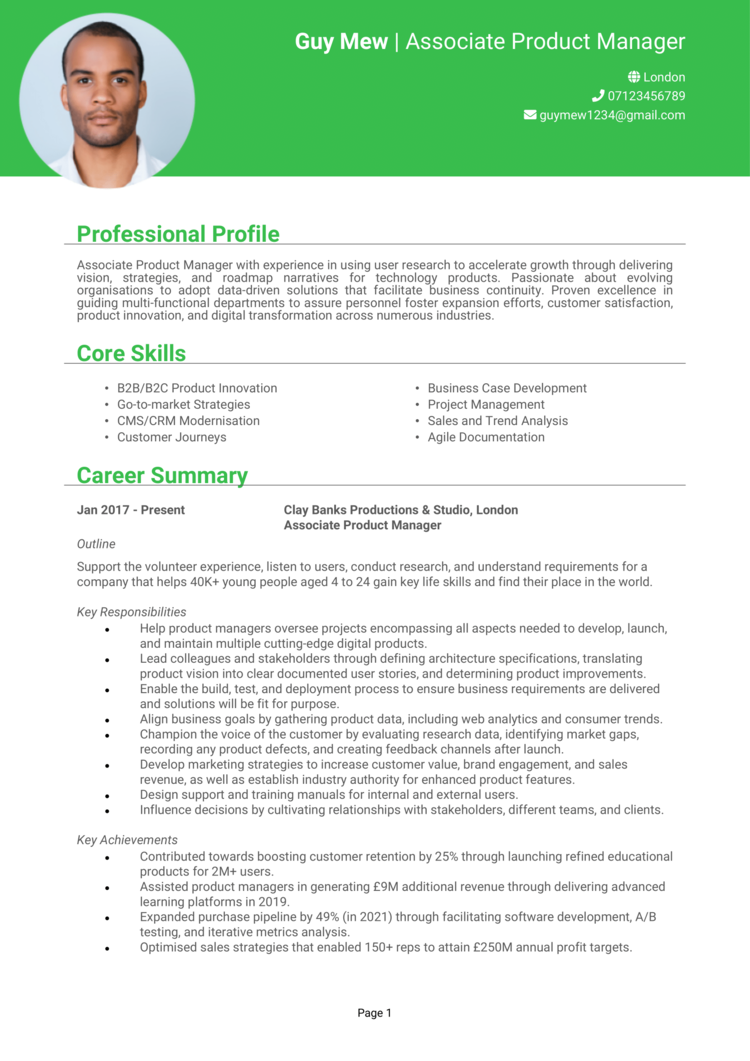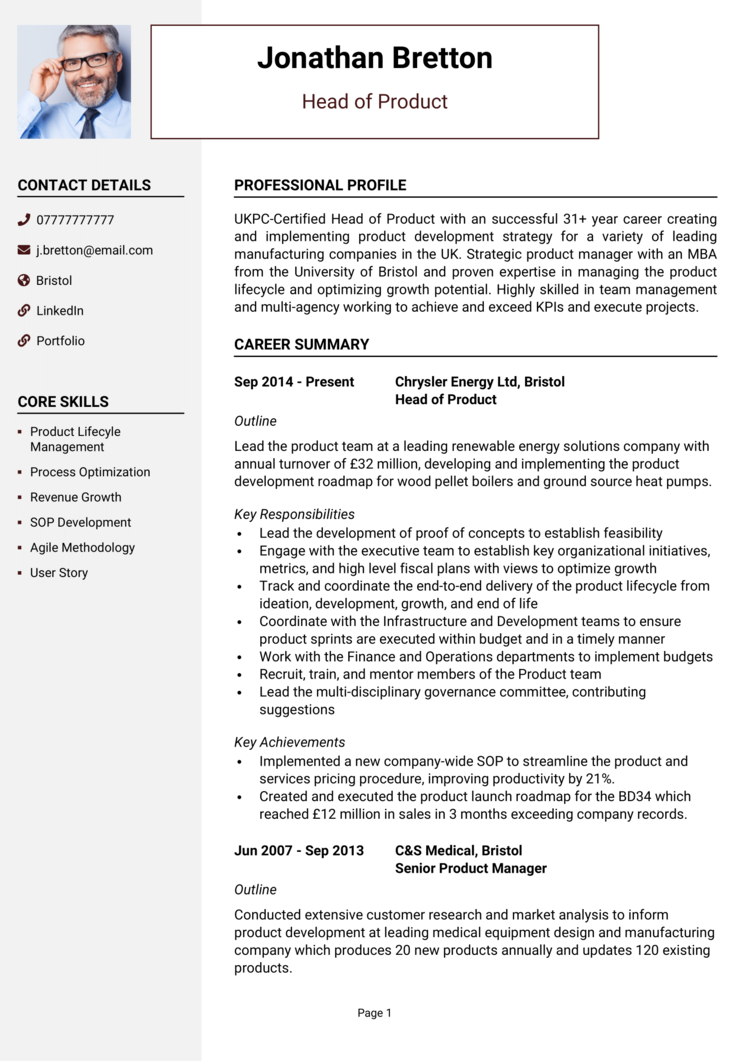As a Product Manager, you know the importance of keeping things on track – let’s start with your own job search. Before you can manage a single roadmap in the office, you need to navigate your way onto a recruiter’s shortlist.
This guide, complete with Product Manager CV examples, will help you showcase your strategic thinking, technical expertise, and leadership skills to land your next role in product management.
Product Manager CV example

Associate Product Manager CV

Head of Product CV example

Junior Product Manager CV

How to write your Product Manager CV
Learn how to create your own interview-winning Product Manager CV with this simple step-by-step guide.
Writing a CV for a Product Manager role is about more than just listing your experience. You’ll need to highlight your ability to align teams and deliver products that exceed user expectations.
This guide will show you how to craft a CV that demonstrates your unique combination of business savvy, technical knowledge, and creative problem-solving.
Structuring your Product Manager CV


A Product Manager’s CV needs to be as structured and efficient as a well-planned product roadmap. Recruiters need to find your key qualifications and achievements at a glance: don’t make them hunt through an innavigable mess of an application.
Here’s how to structure your Product Manager CV:
- Name and contact details – Have your personal details at the top so hiring managers can easily get in touch when they’re ready to hire. Placing a photo is optional, and generally isn’t required.
- Profile – Start with a snapshot of your product management skills, career highlights, and professional aspirations.
- Core skills – Quickly list your biggest strengths, like stakeholder management, market analysis, and product lifecycle management.
- Work experience – Start with your most recent role and work backwards, showcasing achievements and responsibilities.
- Education – Here is where you can mention your degrees, certifications, and any training that supports your career path.
- Additional info – Include any additional details, like hobbies and interests or memberships, that reflect leadership, problem-solving, or creativity.
How to format your Product Manager CV


Your CV should look as polished and professional as the MVPs you’ve delivered. A clean, easy-to-read format ensures that your skills and experience take centre stage.
Remember, even the most qualified candidates can lose out if their CV looks more like a backlog than a finished product: avoid preventable formatting mistakes.
Here’s how to format your Product Manager CV:
- Bullet points – Use short, sharp bullet points to present your responsibilities and achievements clearly.
- Divide sections – Use bold headings and consistent spacing to make your CV layout easy on the eye and even easier to navigate.
- Use a clean font – Choose a professional, readable font that keeps the focus on your content.
- Keep it the right length – Aim for 2 pages—plenty of space to show your expertise without overwhelming the reader.
Product Manager CV profile


Your CV profile is the first thing recruiters will read, so it needs to deliver a clear summary of your product management skills and accomplishments.
Product Manager CV profile examples
Profile 1
Dynamic Product Manager with five years of experience in software development, specialising in leading cross-functional teams to deliver innovative digital products. Skilled in Agile methodologies, roadmap planning, and market research to drive user-centric solutions.
Profile 2
Experienced Senior Product Manager with over eight years of expertise in managing end-to-end product lifecycles for SaaS platforms. Adept at defining vision, aligning stakeholder expectations, and delivering scalable solutions that meet business goals. Skilled in JIRA, Confluence, and Tableau for data-driven decision-making.
Profile 3
Organised Product Manager with three years of experience in e-commerce, focusing on optimising product performance and user experience. Proficient in A/B testing, data analytics, and collaborating with UX designers to enhance customer satisfaction.
What to include in your Product Manager CV profile
Here are some tips on what to include in your Product Manager profile:
- Where you’ve worked – Mention industries or companies you’ve worked for, such as SaaS, e-commerce, or tech startups.
- Your top qualifications – Highlight degrees, certifications, or relevant training in business, IT, or product management.
- Key skills – Include expertise like roadmap creation, user research, or cross-functional collaboration.
- Types of products you’ve managed – Mention digital platforms, mobile apps, or physical goods you’ve worked on.
- Stakeholders you’ve collaborated with – Reference working with developers, designers, or executives.
Presenting your core skills


Your core skills section is like your feature list – short and sharp, and designed to wow the end user (in this case, the recruiter).
For Product Managers, this section should highlight your ability to manage products through their lifecycle, coordinate teams, and analyse market trends: specific, tangible skills that’ll prove valuable in the workplace.
Tailor it to the role by making use of the job description, which helpfully tells you exactly what the recruiter wants.
Top skills for your Product Manager CV
- Roadmap Planning – Defining and managing product roadmaps to align with business goals.
- Stakeholder Management – Coordinating with developers, designers, and executives to deliver products on time.
- Market Research – Identifying user needs and market trends to inform product strategies.
- Product Lifecycle Management – Overseeing products from ideation to launch and beyond.
- User Story Creation – Writing detailed user stories to guide development teams.
- Data Analysis – Using metrics and analytics to assess product performance and guide decisions.
- Agile and Scrum Methodologies – Leading teams in iterative development processes.
- Wireframing and Prototyping – Collaborating on design concepts to validate ideas.
- Customer Feedback Integration – Turning user insights into actionable product improvements.
- Budget Management – Allocating resources effectively to maximise ROI.
Work experience


Think of your work experience section as your release notes – it shows recruiters what you’ve done, what you’ve improved, and why they should hire you. It’s where you demonstrate your impact as a Product Manager.
Highlight your contributions to successful product launches, team alignment, and strategic growth, writing your job history in reverse chronological order.
Formatting your job history for your CV

- Outline – Provide an overview of the company, your role, and the types of products you managed.
- Responsibilities – Highlight tasks like managing roadmaps, conducting user research, or leading cross-functional teams. Use action verbs like “developed,” “aligned,” or “prioritised.”
- Achievements – Showcase measurable outcomes, such as increasing user retention, boosting revenue, or launching a product ahead of schedule. Always include figures where possible.
Example jobs for Product Manager
Product Manager | InnovateTech
Outline
Managed the development and launch of digital products, working closely with cross-functional teams to deliver user-centric solutions. Focused on improving product-market fit and achieving business objectives.
Responsibilities
- Led the design and launch of a business process automation tool used by 50+ clients, achieving a 15 percent reduction in their operational costs.
- Oversaw a team of 10 developers and UX designers, coordinating Agile sprints to deliver products on time and within a £400,000 budget.
- Worked closely with clients to gather requirements, ensuring product alignment with user needs.
- Monitored product performance post-launch, using analytics to identify and address areas for improvement.
- Streamlined internal team workflows, reducing development cycle times by 20 percent.
Achievements
- Delivered a product that reduced clients’ data processing time by 25 percent, driving higher customer satisfaction.
- Consistently completed projects ahead of deadlines, saving the company an average of 10 percent in resource costs per project.
- Received recognition for achieving a 95 percent customer retention rate across all product deployments.
Senior Product Manager | Digital Dynamics
Outline
Led the product strategy for a portfolio of SaaS platforms, driving innovation and business growth. Managed a team of product managers to deliver scalable solutions aligned with company objectives.
Responsibilities
- Developed and executed a product roadmap for a financial compliance platform used by 100+ institutions, resulting in a 30 percent increase in annual recurring revenue.
- Oversaw product development with a £1M budget, ensuring seamless integration with existing client systems.
- Collaborated with sales and marketing teams to position products effectively in the financial services market.
- Used customer feedback and market trends to prioritise high-impact features, ensuring continuous product improvement.
- Mentored a team of junior product managers, improving team output by 20 percent.
Achievements
- Reduced clients’ compliance audit times by 40 percent through automation features.
- Secured an additional £2M in client contracts through the successful delivery of innovative product updates.
- Achieved a 20 percent improvement in internal team efficiency by implementing process optimisations.
Product Manager | E-Sales Growth
Outline
Focused on improving the performance and user experience of e-commerce products. Collaborated with teams to optimise online shopping features and ensure seamless user journeys.
Responsibilities
- Led the redesign of the company’s mobile app and website, managing a £300,000 project budget and a team of 12 developers and designers.
- Conducted A/B testing and user surveys to inform design decisions and improve navigation.
- Integrated payment gateway updates to enhance security and reduce checkout time by 10 percent.
- Collaborated with marketing teams to implement personalised product recommendations, boosting upselling opportunities.
- Monitored user analytics to identify pain points and prioritise feature development.
Achievements
- Increased mobile app downloads by 25 percent in the first quarter after the update.
- Improved the site’s conversion rate by 20 percent through user-centric design enhancements.
- Reduced shopping cart abandonment rates by 15 percent, contributing to a £500,000 increase in quarterly revenue.
How to list your educational history


The education section should highlight your academic background and any professional certifications relevant to product management.
List your qualifications in reverse chronological order, starting with the most recent. Include certifications like Scrum Master or Product Owner where applicable.
Best qualifications for Product Managers
- Certified Scrum Product Owner (CSPO) – Training in managing product backlogs and working with Agile teams.
- Pragmatic Institute Certification – Expertise in market-driven product management.
- Google Data Analytics Certificate – Proficiency in analysing data to inform product strategies.
- Bachelor’s Degree in Business Administration – Foundational training in business operations and strategy.
- Lean Six Sigma Certification – Skills in process improvement and operational efficiency.





